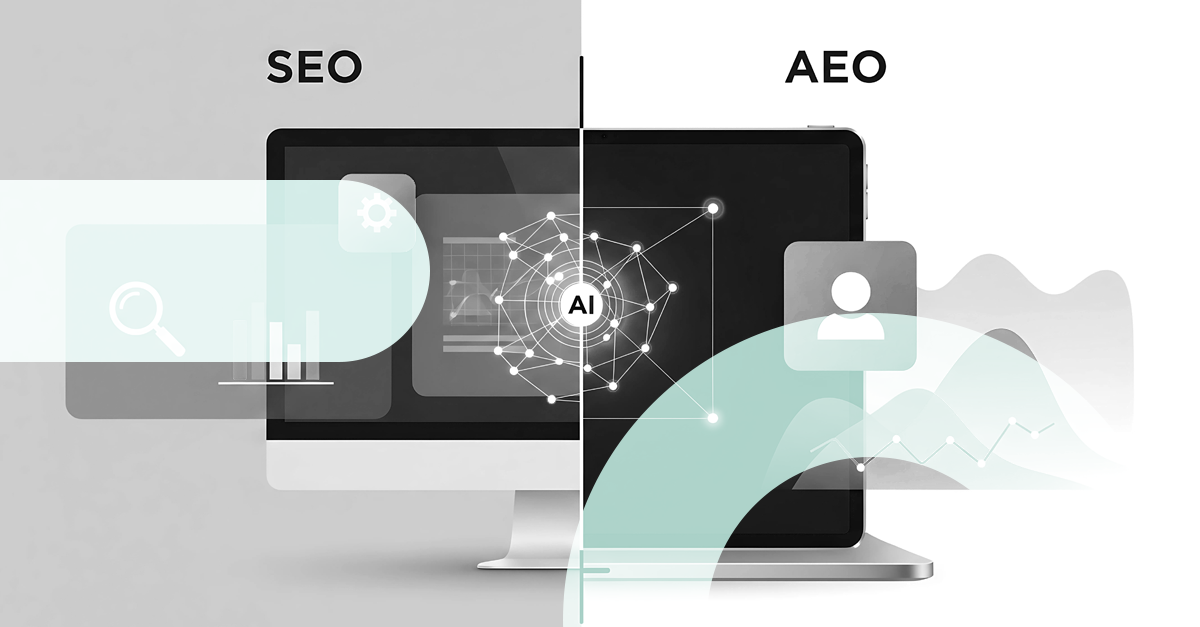The constant pressure from algorithms, technologies, and search engines has generated a shift within the universe of digital marketing in the way brands connect with users, and this is where SEO has been king for years. However, in recent years, another term has gained prominence: AEO (Answer Engine Optimization).
While SEO focuses on optimizing content to improve visibility in search engines through techniques and strategies, AEO responds to the growing trend of prioritizing direct and concise answers aimed at intelligent assistants. Understanding these differences is key to developing an effective digital strategy in an AI-driven environment.
Stay tuned, because we are going to explore what each term means, how it works, and why understanding their differences can make the difference between appearing or being invisible in search engines.
What´s AEO?
AEO stands for Answer Engine Optimization, or in other words, Optimization for Answer Engines. Unlike more traditional on-page SEO, AEO aims to optimize content for what are now known as virtual assistants. The new landscape requires visibility in ChatGPT, Siri, or Alexa and, although they draw from search engines, they function differently.
That is why, instead of offering links and enriched information, the goal is to provide the user with a more precise answer. We could say that AEO is not about rankings, but about content structures for interpretation.
| Characteristics |
SEO |
AEO |
| Main objective |
Ranking pages in search results |
Being chosen as a direct awnser in answer engines |
| Type of search |
Written text (traditional searh in Google, Bing, etc) |
Voice or conversational language (assistants and AI models) |
| Search intent |
Navigational, informational, transactional |
Specific questions phrased naturally |
| Content optimization |
Keywords, backlinks, loading times, technical structure |
Clear, concise answers, semantics, question–answer format |
| Ideal type of content |
Long articles, well-structured pages |
Short paragraphs, lists, tables, enriched snippets |
| Complementary technician |
Technical SEO, link building, on-page optimization |
Schema markup, structured data, featured snippets |
| Target platforms |
Google, Bing, Yahoo, traditional search engines |
Google Assistant, Alexa, Siri, ChatGPT, other conversational assistants |
Discover how to improve your SEO ranking with Pillar Pages
What are the main differences between AEO and SEO?
Although SEO and AEO share the goal of improving visibility in search engines, they differ in focus, objectives, and approach. Understanding this is key to targeting strategies and defining action plans aimed at achieving visibility.
Below, we outline the main differences between the two approaches:
1. Search intent and format
SEO is designed for the traditional search engine user—typically Google. It relies on a combination of technical factors and content, covering multiple interconnected areas to build an effective strategy (authority, quality, links, analysis, etc.).
AEO, on the other hand, is focused on answering questions. Like Google, but conversationally and concisely. This is the type of search performed with a voice assistant or AI. With the emergence of Overviews, AEO is now being integrated into traditional SEO.
2. How content is presented
In conventional SEO, content can have various structures and hierarchies. In AEO, content follows a more fixed and concise structure. SEO strategies often facilitate this by using lists, short paragraphs, and structured data.
3. Technical vs. semantic focus
SEO relies heavily on technical optimization, while AEO emphasizes semantics, context, and information accuracy. Content must directly answer the user’s specific question.
4. Expected outcome
SEO success is measured by search engine rankings and the organic traffic they generate. AEO aims for content to be read or displayed as the direct answer.
5. Platforms for visibility
A key difference between AEO and SEO is where and how optimized content appears. This affects strategy, content format, user experience, and business outcomes.
SEO is designed to rank content on traditional search engines such as:
-
Google (the global leader)
-
Bing (owned by Microsoft)
-
Yahoo!
-
DuckDuckGo (privacy-focused)
-
Yandex (popular in Russia)
-
Baidu (dominant in China)
These engines display results in the form of SERPs (Search Engine Results Pages)—lists of links with titles, descriptions, enriched links, images, or snippets. Users choose which link to open based on relevance. Traditional SEO improves visibility through factors such as:
-
Relevant keywords
-
Site structure
-
Backlinks
-
User experience
-
Page speed
-
Domain authority
User intent can vary: looking for information, products, comparisons, navigating to a specific site, or performing an action (like purchasing or signing up).
AEO advantages
Evolution. AEO represents a new way of positioning content and has even changed how SEO is applied for people. Strategies no longer only serve the traditional search engine user; they provide users with direct, concise solutions. Being present is no longer enough—your content must be chosen as the best answer.
Among its advantages, greater visibility through virtual assistants like ChatGPT helps strategists create highly optimized, answer-focused content, especially with AI Overviews.
AEO not only encourages clearer content but also improves user experience by reducing search time, increasing conversions, and quickly satisfying user needs.
AEO doesn’t replace SEO—it complements it. In 2025, this answer-focused strategy creates a new landscape for Google, which has adapted by improving semantic coverage and rewarding content that effectively answers queries in AI snippets. In a world of natural language and conversational queries, SEO and AEO now work together to provide a complete user experience.
In conclusion, AEO allows you not only to anticipate how users will search for information in the AI era but also to claim a privileged place in the digital conversation—sometimes even above traditional search results.
AEO trends in SEO in 2025
In 2025, Answer Engine Optimization has become a key pillar within the SEO ecosystem. It is no longer an emerging concept to keep in mind; it’s a central element of modern digital strategies. As AI advances rapidly and Google adapts, all these actors converge to create new spaces, such as AI Overviews.
Content not optimized for clarity, authority, and structured answers risks losing organic visibility.
Google’s new AI Overviews are designed to provide AI-generated answers directly in search results. Instead of showing only links, Google now displays summaries that condense the most relevant information from multiple sources. While these answers rely on traditional SERP content, the best-resolving content is rewarded.
If you need to adapt your strategy to this evolution, our inbound marketing agency specialized in SEO can help you implement content aligned with this new paradigm.
Current algorithms leverage AI—they do not replace SEO. SEO remains more important than AI; it hasn’t disappeared, it has evolved in harmony with new ecosystems. This is largely due to the growth of integrated assistants on devices. Previously, people asked questions by voice; now, they use AI. However, SEO continues to feed those answers.
AEO is no longer a secondary tactic. In 2025, it is a strategic requirement for standing out in the new visibility spaces defined by intelligent search engines. Being chosen as “the best answer” not only improves visibility but also boosts brand authority in increasingly competitive, generative environments.
If you want your website to compete in this new scenario, contact us to audit your situation and define the best strategy for your business.





